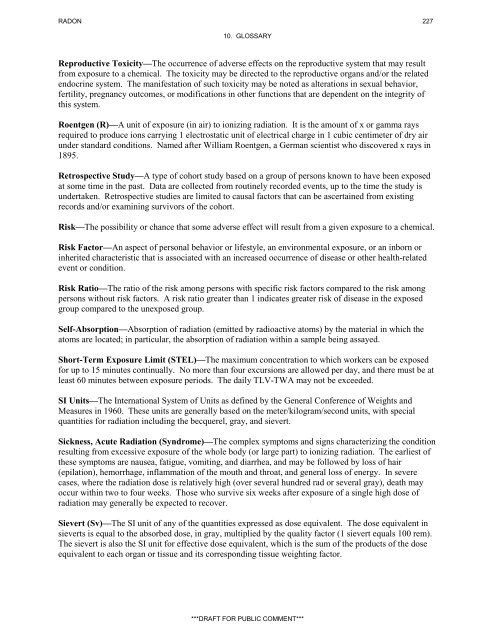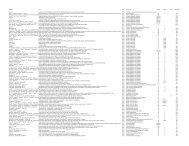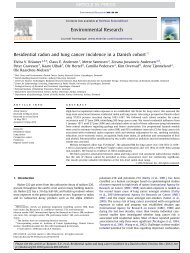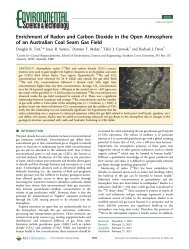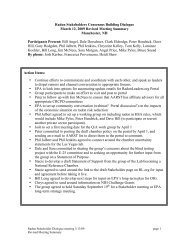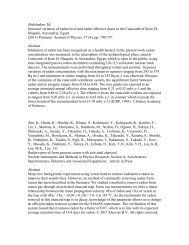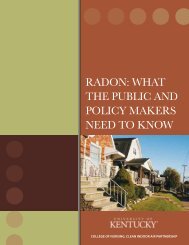ATSDR Draft Toxicological Profile for Radon_September 2008.pdf
ATSDR Draft Toxicological Profile for Radon_September 2008.pdf
ATSDR Draft Toxicological Profile for Radon_September 2008.pdf
You also want an ePaper? Increase the reach of your titles
YUMPU automatically turns print PDFs into web optimized ePapers that Google loves.
RADON 22710. GLOSSARYReproductive Toxicity—The occurrence of adverse effects on the reproductive system that may resultfrom exposure to a chemical. The toxicity may be directed to the reproductive organs and/or the relatedendocrine system. The manifestation of such toxicity may be noted as alterations in sexual behavior,fertility, pregnancy outcomes, or modifications in other functions that are dependent on the integrity ofthis system.Roentgen (R)—A unit of exposure (in air) to ionizing radiation. It is the amount of x or gamma raysrequired to produce ions carrying 1 electrostatic unit of electrical charge in 1 cubic centimeter of dry airunder standard conditions. Named after William Roentgen, a German scientist who discovered x rays in1895.Retrospective Study—A type of cohort study based on a group of persons known to have been exposedat some time in the past. Data are collected from routinely recorded events, up to the time the study isundertaken. Retrospective studies are limited to causal factors that can be ascertained from existingrecords and/or examining survivors of the cohort.Risk—The possibility or chance that some adverse effect will result from a given exposure to a chemical.Risk Factor—An aspect of personal behavior or lifestyle, an environmental exposure, or an inborn orinherited characteristic that is associated with an increased occurrence of disease or other health-relatedevent or condition.Risk Ratio—The ratio of the risk among persons with specific risk factors compared to the risk amongpersons without risk factors. A risk ratio greater than 1 indicates greater risk of disease in the exposedgroup compared to the unexposed group.Self-Absorption—Absorption of radiation (emitted by radioactive atoms) by the material in which theatoms are located; in particular, the absorption of radiation within a sample being assayed.Short-Term Exposure Limit (STEL)—The maximum concentration to which workers can be exposed<strong>for</strong> up to 15 minutes continually. No more than four excursions are allowed per day, and there must be atleast 60 minutes between exposure periods. The daily TLV-TWA may not be exceeded.SI Units—The International System of Units as defined by the General Conference of Weights andMeasures in 1960. These units are generally based on the meter/kilogram/second units, with specialquantities <strong>for</strong> radiation including the becquerel, gray, and sievert.Sickness, Acute Radiation (Syndrome)—The complex symptoms and signs characterizing the conditionresulting from excessive exposure of the whole body (or large part) to ionizing radiation. The earliest ofthese symptoms are nausea, fatigue, vomiting, and diarrhea, and may be followed by loss of hair(epilation), hemorrhage, inflammation of the mouth and throat, and general loss of energy. In severecases, where the radiation dose is relatively high (over several hundred rad or several gray), death mayoccur within two to four weeks. Those who survive six weeks after exposure of a single high dose ofradiation may generally be expected to recover.Sievert (Sv)—The SI unit of any of the quantities expressed as dose equivalent. The dose equivalent insieverts is equal to the absorbed dose, in gray, multiplied by the quality factor (1 sievert equals 100 rem).The sievert is also the SI unit <strong>for</strong> effective dose equivalent, which is the sum of the products of the doseequivalent to each organ or tissue and its corresponding tissue weighting factor.***DRAFT FOR PUBLIC COMMENT***


